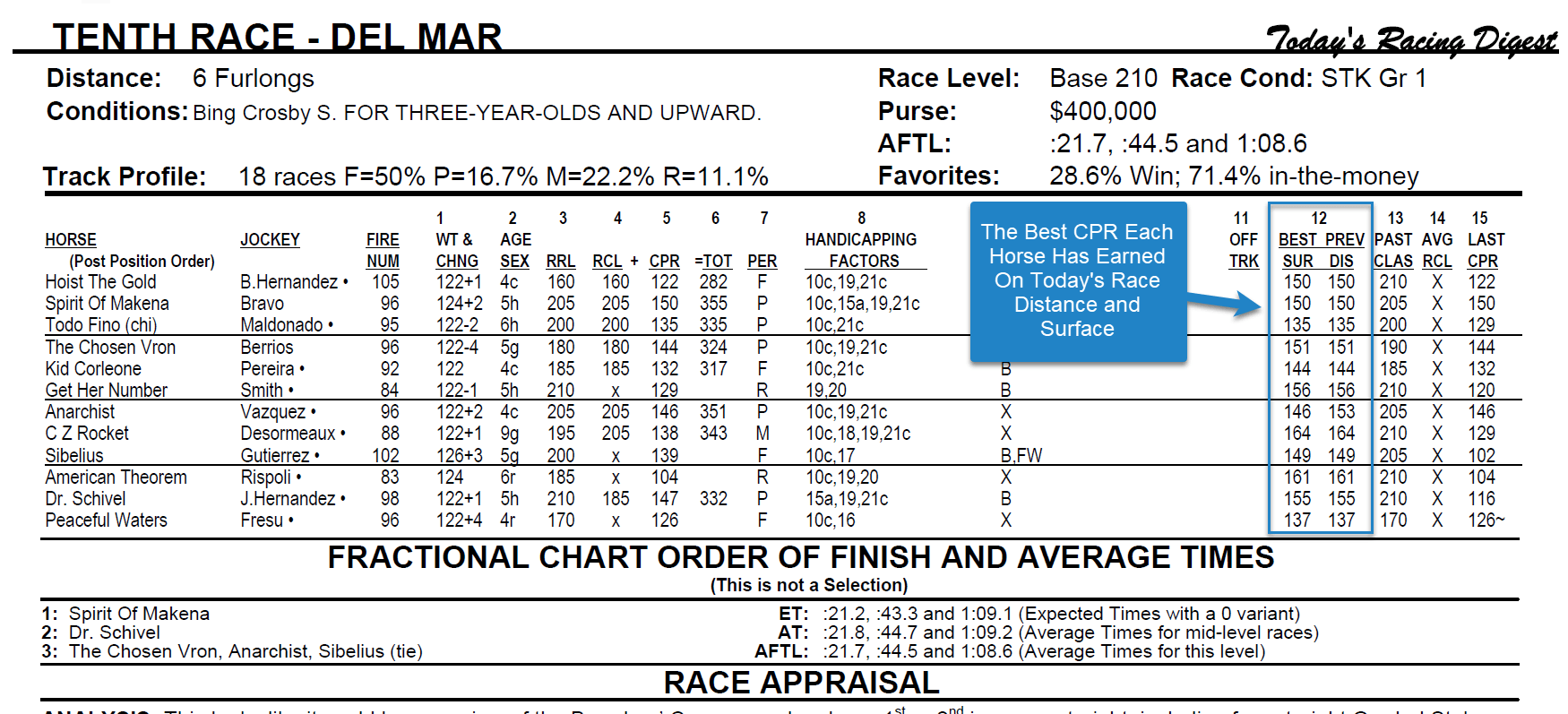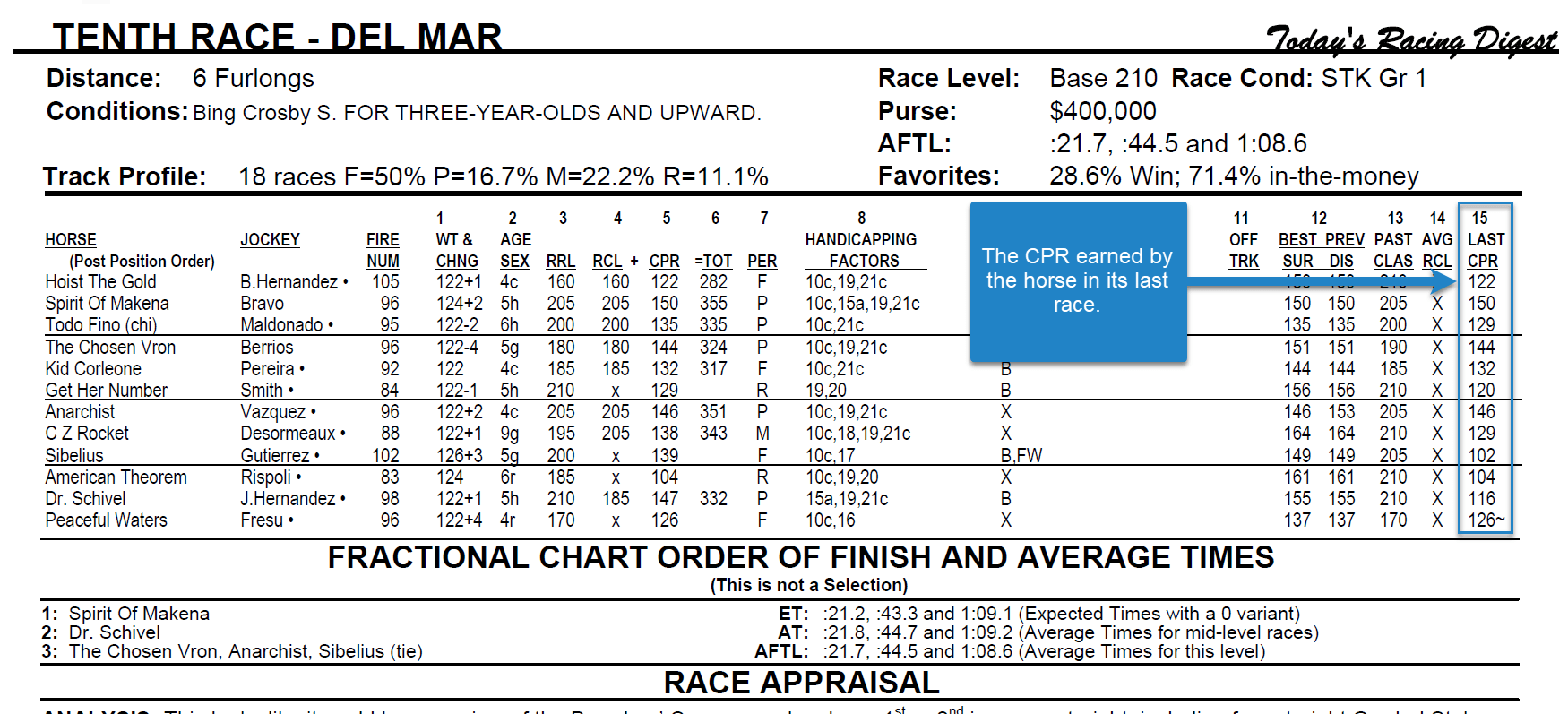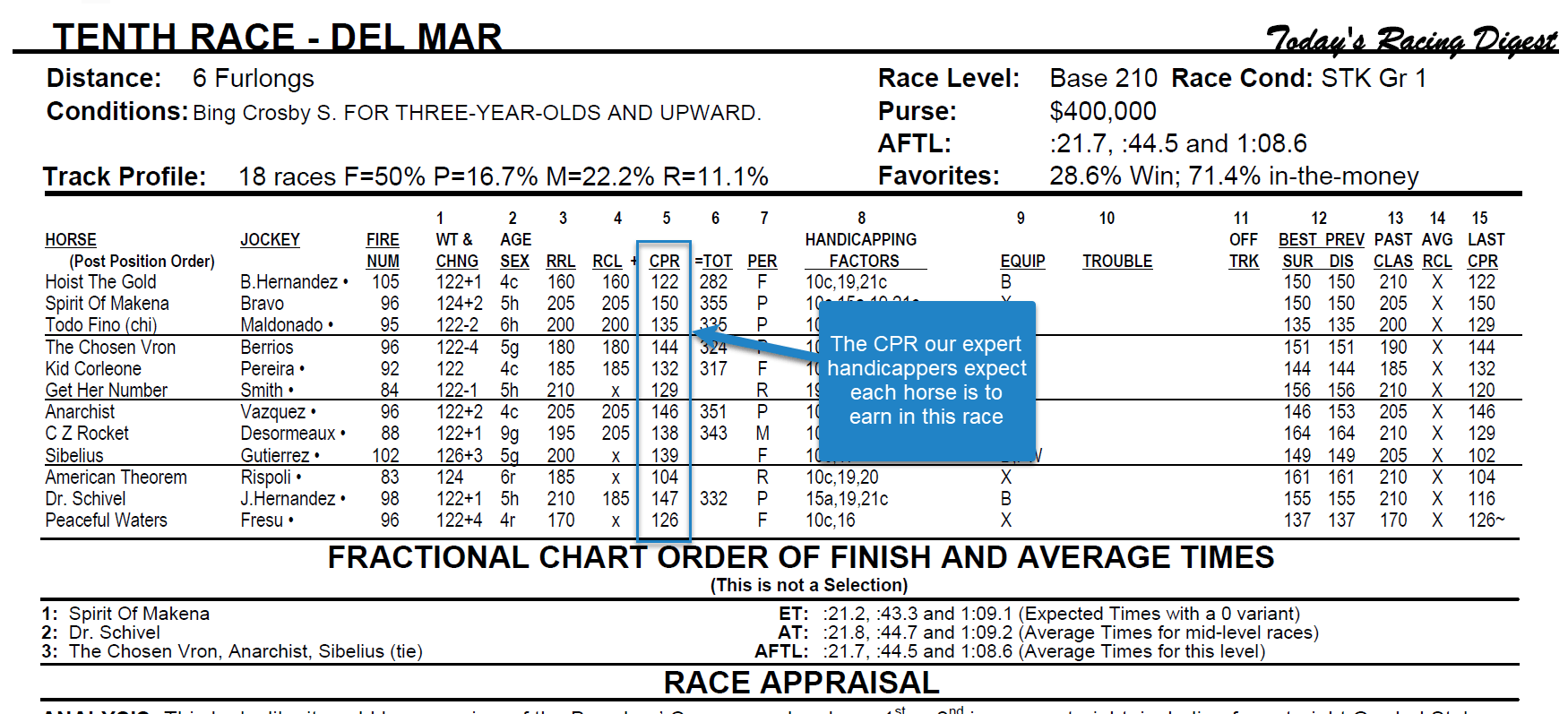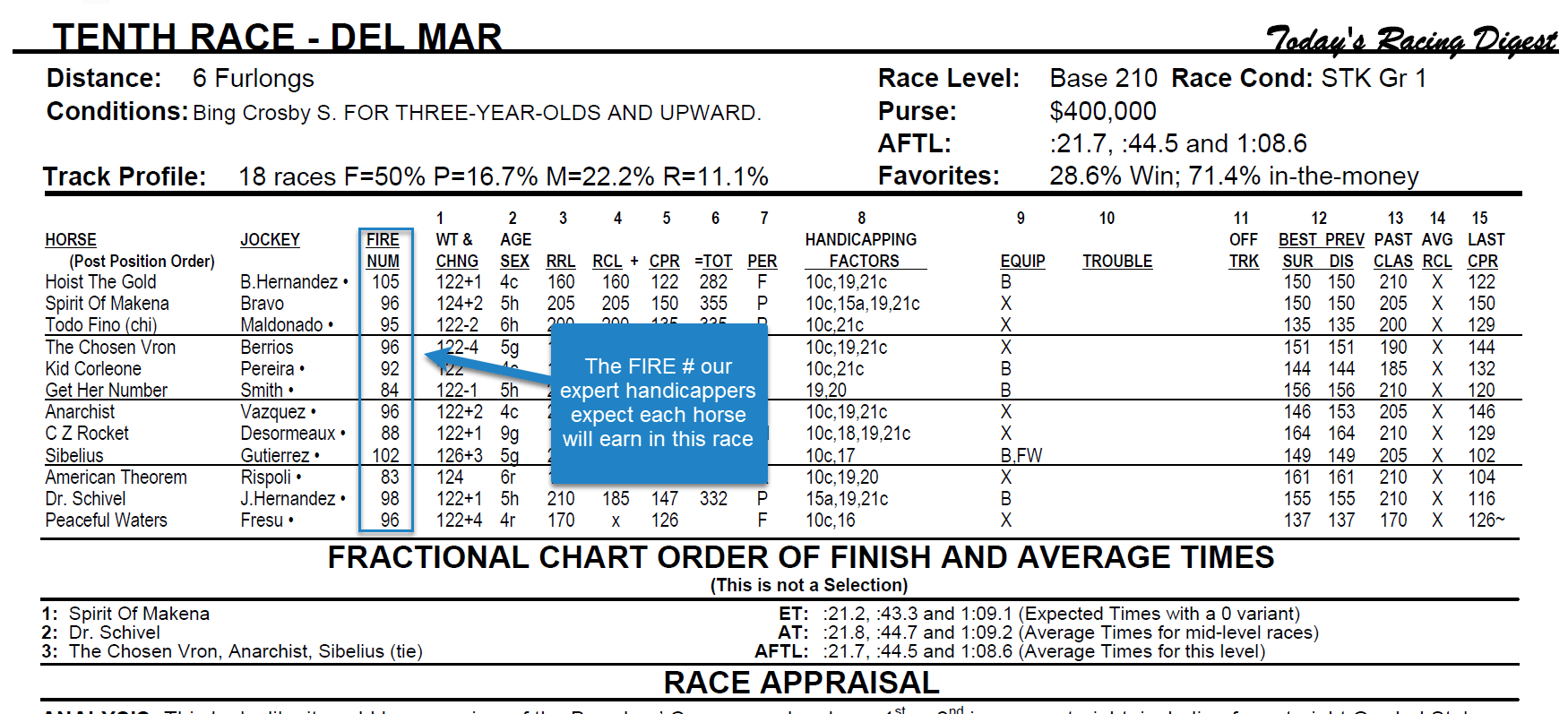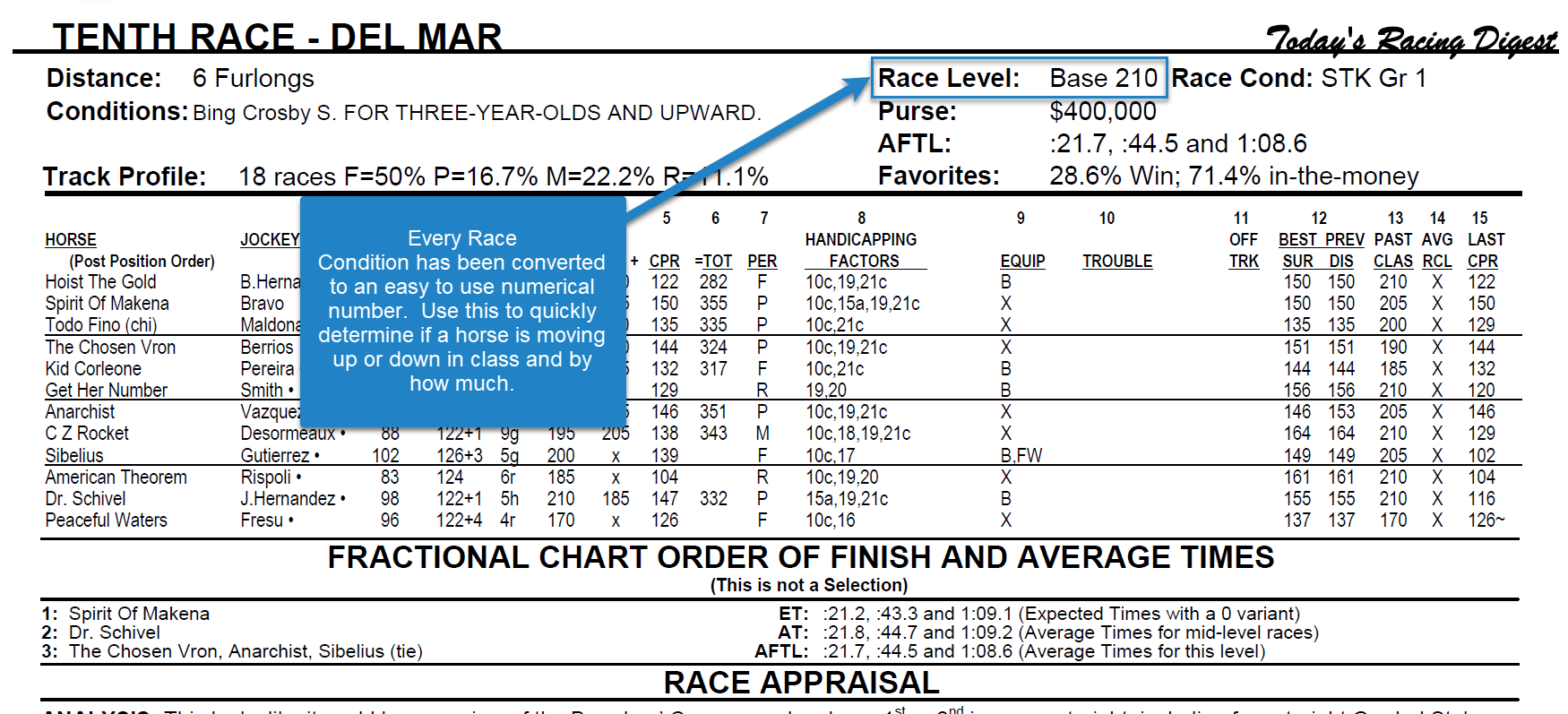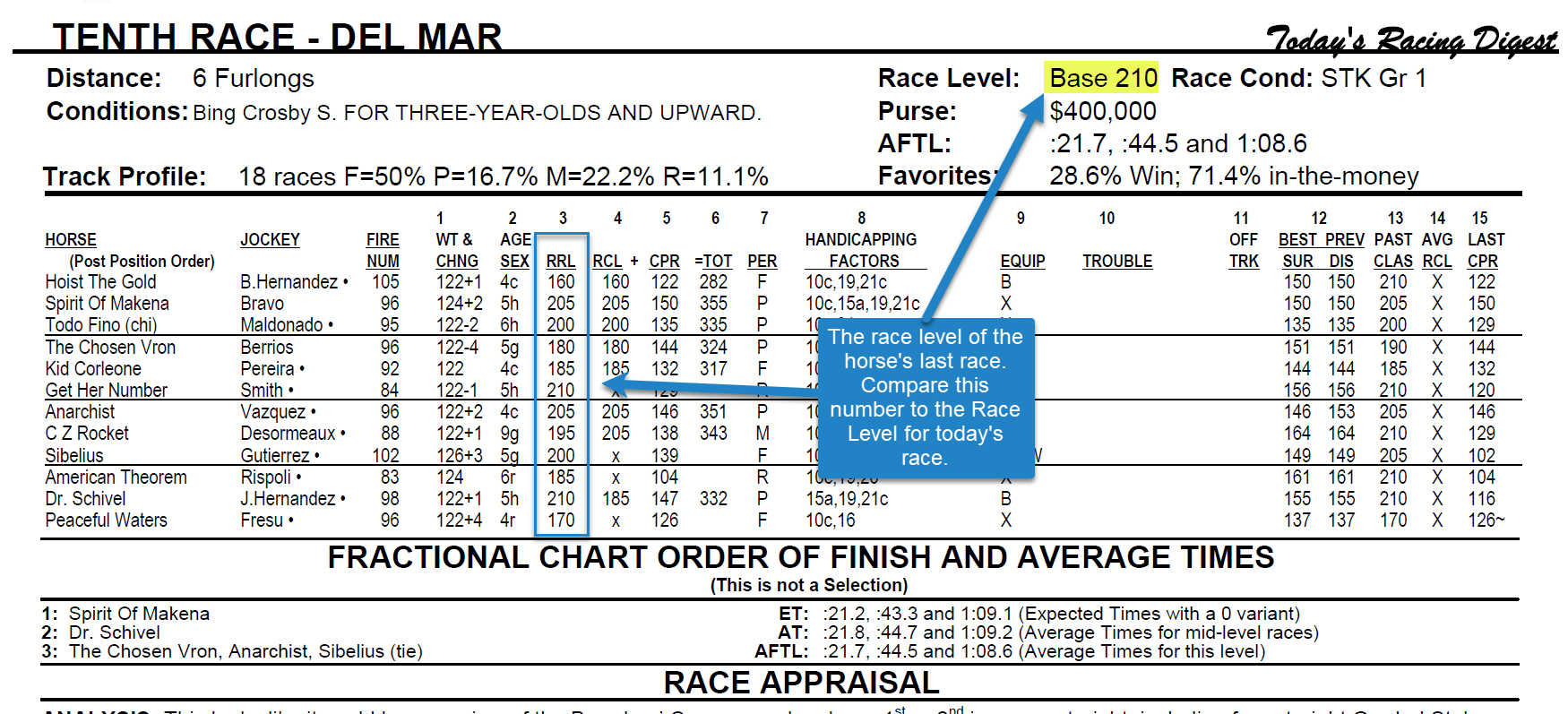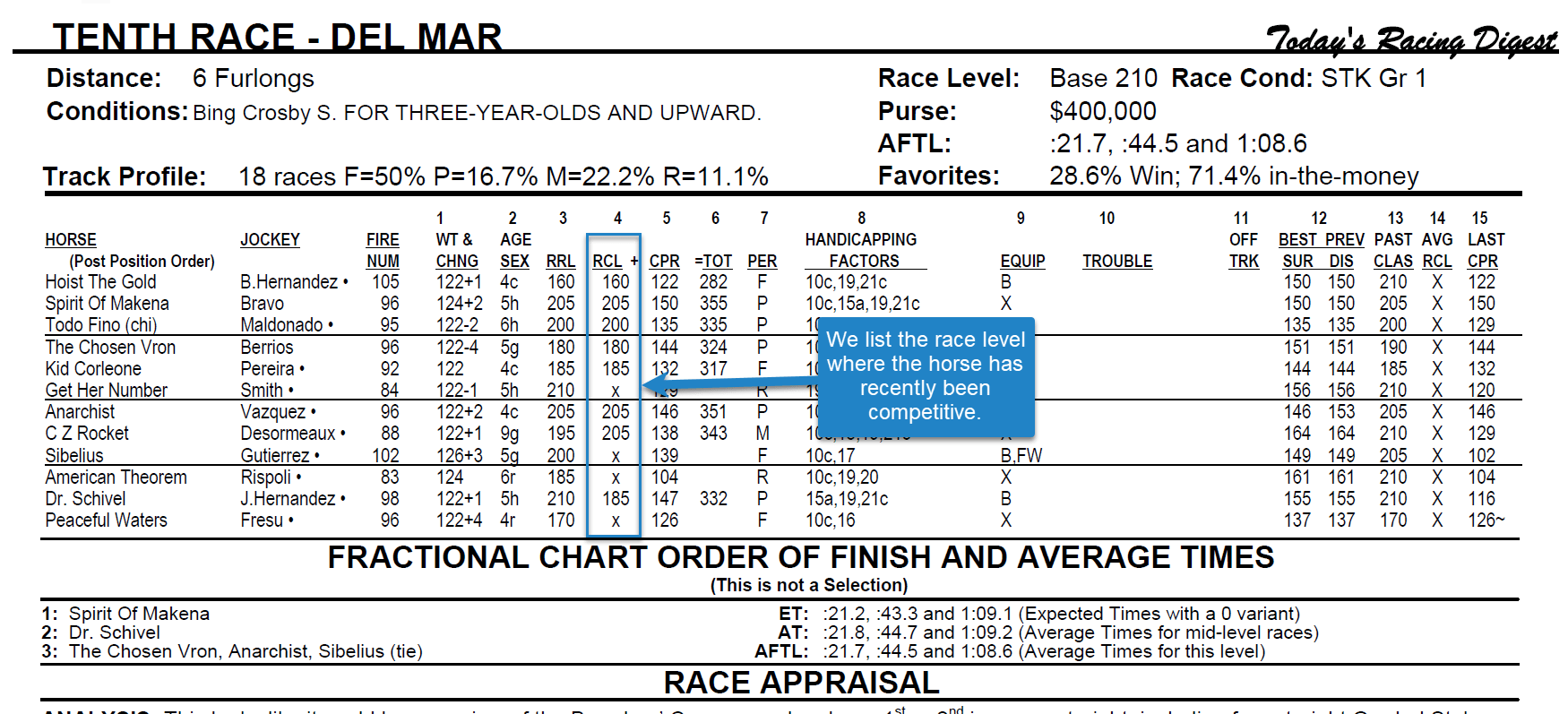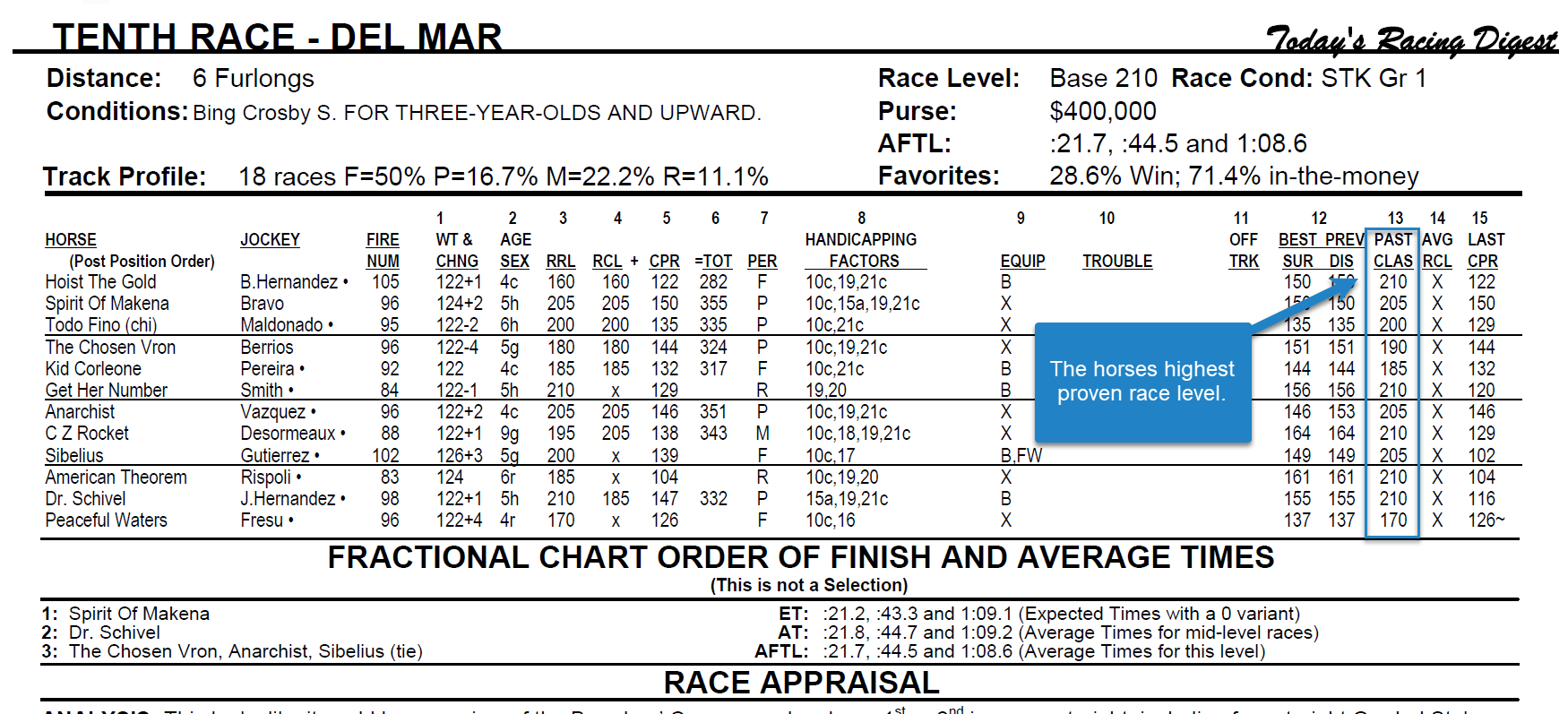Betting Guides, Handicapping 101
How To Handicap Horses in 6 Easy Steps
How To Handicap The Horse Races In 6 Easy Steps
No matter what your level of expertise, it's often wise to "get back to basics" and review the rudimentary elements of this challenging, sometimes exasperating, bit of mental stimulus known as handicapping.
Everyone handicaps differently but these elements should always be addressed before making a wager. They are offered in order of importance to the overall equation.
Today's Racing Digest's Complete Digest makes it easy to quickly go through these 6 steps for each race helping you isolate contenders while uncovering false favorites, overlooked long-shots and hidden value.
See How To Use These 6 Handicapping Steps With The "Digest" Race Sheets
Step #1 FORM
Nothing else really matters if a horse is not in "form" and the first task in attacking a race is to eliminate those runners that don't appear to be fit from a condition standpoint, either through recent racing or with a string of workouts that suggest the animal is set to do its best work. A competitive recent race (accompanied by the necessary a.m. maintenance if it's last race was more than two weeks ago) is the most reliable indicator for fitness.
Horses that haven't raced in 30+ days or don't have a history of performing well coming off of breaks should offer ample workout evidence that they have a recent string of workouts that suggest the horse is fit from a condition standpoint.
The group that doesn't fit into this rather wide parameter should be eliminated from further consideration, allowing the handicapper to concentrate on the true contenders. It doesn't matter what a horse has done in the past if it doesn't look capable of running well today. On the other hand, don't be quick to draw an "x" through potential long-shots that come off bad lines if they had legitimate excuses like racing at an unsuitable distance, on an unsuitable surface, fought a strong track bias, is moving from a losing barn to a winning one or has been given a freshener followed by positive workout activity.
-How to identify horses that are in form -
Identify how frequently the horse has been racing
In the horse's past performances you will see up to the last 6 starts for each of the horse's running. To determine recency, check the date of the last few starts. Horses that haven't raced in 30+ days should have a history of performing well off short (or longer) breaks and come from barns that regularly win races.
Identify how frequently the horse has been working
In the horse's past performances you will see up to the last 6 starts for each of the horse's running. To determine recency, check the date of the last few starts. Horses that haven't raced in 30+ days should have a history of performing well off short (or longer) breaks and come from barns that regularly win races.
Know if the workouts suggest the horse is set to give its best performance
Today's Racing Digest's exclusive workout report (included in the "Complete Digest" for Southern California) provides you comments about the quality of the works while noting exceptional as well as poor works.
Strong Final Time Ratings usually indicate a horse is in good form
While the pace often can influence a horse's Final Time Rating (e.g., an easy lead, speed duel, etc.) horses with strong Final Time Ratings compared to their competition often run well right back. The Final Time Rating is a Digest exclusive performance figure that only takes into account the final time of the horse against our track pars, with the daily track variant factored in. A horse equaling the track par for the distance would earn a 150 Final Time Rating. Three points are deduced for each length slower than par. You can now easily compare the Final Time Ratings of each of the horse's most recent starts to identify which horse's may be in good form.
Does the horse perform well coming off breaks?
To determine if a horse has a history of performing well off short or longer breaks you can look at date between the horses past performances and check the Finish Position (FIN POS/BTN LNGH) column to see how that horse performed in the race following a break.
See how the trainer does with horses coming off a layoff
Check the trainer stats in the race sheets under the horses data box. If the horse has not run within 30, 60, or 90+ days or the horse is making a 2nd or 3rd start after 90+ layoff you will see the percentage of wins, along with the number of starts, wins, places and shows for the trainer for each layoff condition.
Step #2 ABILITY
How fast can the remaining horses in the field run on their best day? That's the next question to be answered. There are many different ways to evaluate talent in this era of speed figures and performance ratings. Whether you use Today's Racing Digest's CPRs, FIRE Numbers or Final Time Ratings, Fast Figs, Beyer Ratings, the "sheets", or make your own doesn't really matter but you should be consistent. The task at hand is to determine two things: What is the horse capable of doing?; and, what does it figure to do today? Those horses that do not figure within three lengths of the top contenders in the race can be eliminated.
-How to identify horses that have the ability to win today's race -
Determine the best each horse has done at today's race distance and surface
Look in the header in column #12 (Best Prev Sur Dis) and you will find the best Comprehensive Performance Rating (CPR) the horse has earned for the Surface and Distance of today's race. If no rating is shown under both headings, no experience at this distance is recorded. If no rating is shown under Surface the horse has not raced on the surface of today's distance.
Quickly identify how each horse performed in his last race
Understand how the horse performed in his last 6 races
The Comprehensive Performance Rating (CPR) the horse has earned for up to his last 6 starts are listed in the horse's data lines under the CPR heading.
Quickly uncover any trends in a horse's progressing ability
The Final Race Equation (FIRE Number), which takes into account speed throughout the entire race, for up to the horse's last 10 starts are listed on all Digest racing sheets just above the horse's data lines next to the heading "LAST 10 FIRE". Just like the CPR, the higher the number the faster the horse.
Determine what the horse is expect to do today
In the race sheet header in column #5 (CPR) Today's Racing Digest expert handicappers gives you the Comprehensive Performance Rating (CPR) the horse is expected to earn in today's race. The higher the number the better.
Learn how the horse figures in today's race
The FIRE Number listed in the header section of the race sheets in the FIRE NUM column lists what we expect the horse to run today. When using the FIRE number, keep in mind that this number is based on a 100 par, where our other figures are based off a 150 par. Each two points represent approximately one length regardless of distance or surface.
Step #3 CLASS
This is a tricky part of the puzzle since horses can improve and regress quickly in this day-and-age of year-round racing when trainers try and squeeze races out of horses that obviously need a rest and the track veterinarians help them do it with an array of legal medications. Often, outclassed horses will be eliminated in Step #2 but in the case of horses stepping up in class off impressive efforts, it's necessary to analyze how those figs were earned. Horses that benefited from easy pace pictures, strong bias situations or simply raced against a bad bunch of rivals, should be viewed with skepticism when trying to step up to a tougher level. The best class jumpers to play are those that tailed off, dropped in class and are now moving back up while appearing to have regained their form. "Past Class" is a big handicapping plus and is often overlooked by many players.
- How to determine if a horse can win at today's class level -
Today's Racing Digest race sheets makes handicapping class easy by using it's exclusive Race Class Levels (RCL). The RCL's are a simple number system assigned to a certain type of race that represents its position relative to other races. By assigning a numerical value to a race it allows the you to easily discern the quality of one class of horses from another. The Digest does this by designating a number, anywhere from 75 to 210, to each race. The higher the number, the stronger the race.
How to determine the Race Class Level for each race
he Race Level for each race is listed in the top right hand side of the race sheets. This is the number that relates to today's conditions and should be compared with the other class based ratings in the race sheets to determine a horse's ability to compete in today's race class level.
What race level did the horse run in his last race
What's the highest race class level the horse has been competitive in recently
In the race sheet headers (found in the 4th column under RCL in the race sheet header) you can find the Race Competition Level (RCL) which is the Race Class Level the horse has recently been competitive (finished 5th or better and within 5 lengths of the winner) within the last 90 days. An "x" in this column indicates a horse hasn't been competitive at any level recently.
What is the highest class level the horse has ever been competitive at
What Race Class Levels has each horse competed in?
Found in the data lines for each of the horses we list the Race Competition Level for each of the horse's past performances. Compare this number to the Race level in the Race Header and other RCL's to see if this horse has been moving up or down in class and by how much. Be sure to check the Finish Position and Beaten Lengths (FIN POS/BTN LNGH) for this horse's past performance to determine how they performed at that level.
- How to determine if a horse benefited from an easy pace, bias, or soft field -
Learn if the horse benefit from an easy pace
To determine if a horse who won it's last start benefited from a slow pace compare the CPR earned in that race with other CPR's earned by other horses at that same Race Class Level (RCL) where the horse also came in first place. If the CPR is significantly lower than the horse probably benefited from a slow pace.
Learn if the horse benefit from a Track Bias
To determine if the horse benefited from a bias you can look at the Track Bias Column in the past performances This column displays any bias that was in effect during the horse’s race. We note the type of bias (O = outside, I = inside, F = speed bias, L = late runner bias) as well as the strength of the bias on a scale of 1 to 3, with 1 being a mild bias and 3 being a dominant bias.
Discover if the horse ran against a competitive field
To help determine if the horse raced against a competitive field you can check the Key Race Winner feature found in the POS/FLD WINNERS column in the horse's past performances. This shows you how many horses returned from the particular race to win their next starts. Theoretically, the higher the number, the stronger that particular race.
Step #4 RACE CONDITIONS
Does the horse like today's surface and today's distance? Even horses that are in form and have the ability and the class to win are generally beaten when entered in unsuitable races. Some horses move easily between sprints and routes or from dirt to turf while others do not. Before leaving a contender in the mix any longer, be relatively certain in your mind that he'll handle today's conditions.
Does the horse do well in today's race conditions?
Step #5 CONNECTIONS
The human part of the equation is substantial. True, a great rider and an accomplished trainer can't win on a bad horse but by this stage you should have eliminated the "bad" ones. However, "good" horses can be beaten by a jock's poor decision or by a trainer who has a hard time cinching up a saddle correctly. Furthermore, some trainers tend to do well in certain conditions, certain moves, or with certain types of horses. Let the record guide you in this area. Eliminate horse's trained or ridden by traditionally low-percentage stables or jocks and take a long, hard look at short-priced types that are trained or saddled by individuals mired in ongoing slumps. Just as professional athletes in all sports go into slumps, so do trainers and riders. The more they lose, the more they think and the more they think, the more they lose. That's just the way it is.
- How to determine if a trainer and jockey can win today's race -
Know how each trainer does with any moves being made by the horse?
In the Horse Information box in the race sheets the Digest lists all of the pertinent trainer stats you'll need to understand how a trainer has been doing in their last 15 starts (LAST 15) and how they do with any moves they will be making with this horse today (i.e., going from dirt to turf (D/T), route to sprint (R/S, etc).
How successful is the trainer and jockey combination?
It is true that the top jockeys tend to get to ride the top horses. Trainers with the most successful horses will often seek out the services of the most successful jockeys. Additionally, oftentimes when a trainer is serious about his horse’s chances, he’ll employ one of his favorite riders.
In the race sheets under the horse's data box the trainer/jockey combination illustrates the success rate of the jockey and trainer over the past 3 months.The horse's trainer and today's rider are listed, along with their record (starts, wins, 2nds, 3rds) when teaming up over the past three months.
Step #6 BREEDING
Pedigree analysis is only significant when analyzing a horse that has not had ample (or no) opportunity to show what it can do under today's conditions. First-time-starters bred for sprint speed vs. those bred to run best going longer. Sprinters trying to go long. Dirt types moving to turf. The only time you should concern yourself with breeding is when a potential contender has survived the first five steps of this procedure. When playing a horse 'on the come', always get good value and be willing to bet against (or pass the race) when the favorites are not proven under today's conditions, even if their pedigree says they should handle the situation. Just because they're bred to do it, doesn't mean they WILL DO IT, first or second time around anyway.
Learn what the breeding is for each horse
The breeding stats for each horse can be found in the horse's data box in the race sheets. They appear after the sire’s name in the Breeding line of each horse’s comment. When looking at the breeding stats, the first number is the horse’s age, followed by his sex. After the dash(-), the horse’s sire is listed. In parentheses is the sire’s offspring’s win percentage on turf (T), synthetic (S), and in the mud (M). This is followed by the horse’s dam, which is then followed by the dam’s sire (a.k.a – the mom’s dad).
How successful is the trainer and jockey combination?
It is true that the top jockeys tend to get to ride the top horses. Trainers with the most successful horses will often seek out the services of the most successful jockeys. Additionally, oftentimes when a trainer is serious about his horse’s chances, he’ll employ one of his favorite riders.
In the race sheets under the horse's data box the trainer/jockey combination illustrates the success rate of the jockey and trainer over the past 3 months.The horse's trainer and today's rider are listed, along with their record (starts, wins, 2nds, 3rds) when teaming up over the past three months.
After completing these six steps you should have eliminated the pretenders and whittled the field down to the contenders. The more contentious a race looks on paper, the more 'value' you should demand. It makes no sense to back the favorite in a ten-horse field where it looks like five other horses can also win. Make some kind of odds line so that you have an idea of which horses are true overlays in your own mind.
From that point on, it's just a matter of "buy low and sell high".
Class dismissed.








